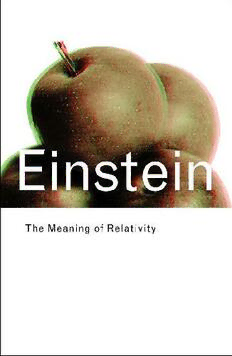
The meaning of relativity PDF
Preview The meaning of relativity
The Meaning of Relativity ‘He was unfathomably profound – the genius among geniuses who discovered, merely by thinking about it, that the universe was not as it seemed.’ Time ‘Einstein’s little book serves as an excellent tying together of loose ends and as a broad survey of the subject.’ Physics Today This page intentionally left blank Albert Einstein The Meaning of Relativity Translated by Edwin Plimpton Adams, with Appendix I translated by Ernst G. Straus and Appendix II by Sonja Bargmann London and New York Vier Vorlesungen ueber Relativitaetstheorie first published 1922 by Vieweg English edition first published in United Kingdom 1922 by Methuen Second edition published 1937 Third edition with an appendix published 1946 Fourth edition with further appendix published 1950 Fifth edition published 1951 Sixth revised edition published 1956 all by Methuen First published in Routledge Classics 2003 by Routledge 11 New Fetter Lane, London EC4P 4EE Routledge is an imprint of the Taylor & Francis Group This edition published in the Taylor & Francis e-Library, 2004. © 1922, 2003 The Hebrew University of Jerusalem All rights reserved. No part of this book may be reprinted or reproduced or utilised in any form or by any electronic, mechanical, or other means, now known or hereafter invented, including photocopying and recording, or in any information storage or retrieval system, without permission in writing from the publishers. British Library Cataloguing in Publication Data A catalogue record for this book is available from the British Library ISBN 0-203-44953-3 Master e-book ISBN ISBN 0-203-45770-6 (Adobe eReader Format) ISBN 0–415–28588–7 (pbk) This book, originally published in 1922, consisted of the text of Dr. Einstein’s Stafford Little Lectures, delivered in May 1921 at Princeton University. For the third edition, Dr. Einstein added an appendix discussing certain advances in the theory of relativity since 1921. To the fourth edition, Dr. Einstein added Appendix II on his Generalized Theory of Gravitation. In the fifth edition the proof in Appendix II was revised. In the present (sixth) edition Appendix II has been re- written. This edition and the Princeton University Press fifth edition, revised (1955), are identical. The text of the first edition was translated by Edwin Plimpton Adams, the first appendix by Ernst G. Straus and the second appendix by Sonja Bargmann. This page intentionally left blank CONTENTS Space and Time in Pre-Relativity Physics 1 The Theory of Special Relativity 24 The General Theory of Relativity 57 The General Theory of Relativity (continued) 81 AppendixI On the ‘Cosmologic Problem’ 112 AppendixII Relativistic Theory of the Non-symmetric Field 136 index 171 A NOTE ON THE SIXTH EDITION For the present edition I have completely revised the ‘Generaliza- tion of Gravitation Theory’ under the title ‘Relativistic Theory of the Non-symmetric Field’. For I have succeeded—in part in col- laboration with my assistant B. Kaufman—in simplifying the derivations as well as the form of the field equations. The whole theory becomes thereby more transparent, without changing its content. A. E. December 1954 SPACE AND TIME IN PRE-RELATIVITY PHYSICS The theory of relativity is intimately connected with the theory of space and time. I shall therefore begin with a brief investiga- tion of the origin of our ideas of space and time, although in doing so I know that I introduce a controversial subject. The object of all science, whether natural science or psychology, is to co-ordinate our experiences and to bring them into a logical system. How are our customary ideas of space and time related to the character of our experiences? The experiences of an individual appear to us arranged in a series of events; in this series the single events which we remember appear to be ordered according to the criterion of ‘earlier’ and ‘later’, which cannot be analysed further. There exists, therefore, for the individual, an I-time, or subjective time. This in itself is not measurable. I can, indeed, associate numbers with the events, in such a way that a greater number is associated with the later event than with an earlier one; but the nature of this association may be quite arbitrary. This association I can
